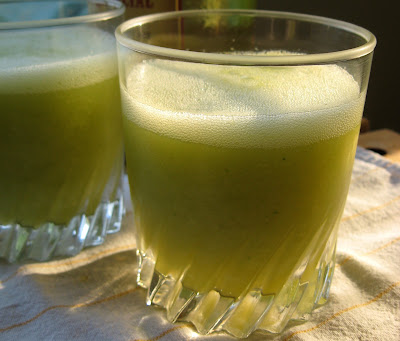Ingredients:
-1 liter of mid-range tequila (I used 30-30 Tequila Reposado, but you can use anything you like)
-1 medium (5-6 inch) cucumber, quartered longways
-1 small/medium jalapeño, also quartered longways
Method:
1. Pour tequila into a half-gallon jar, or split up between two quart jars. (Save the bottle.)
2. Add the cucumber and jalapeño (or split up evenly between whatever jars you're using)
3. Put in a cool, dark place for 4-6 days. I'd recommend that you taste the tequila as it's infusing--I like a spicier infusion, so I let it sit for 6 days. If you'd like it more mild, you could probably let it sit for as few as 3 days.
4. Strain the tequila into the original bottle (or just fish out the cucumber and jalapeño pieces) or a vessel of your choice; discard (or compost) the cucumber and pepper.
5. Serve thoroughly chilled, or make margaritas (see suggested recipe below).
 |
| Using shot glasses to measure; one is orange liqueur, the other is half lime juice/half agave syrup. |
-2 small/medium cucumbers, peeled and rough-chopped
-4 ounces of tequila (cucumber-jalapeño infused tequila, in this case)
-1 ounce orange liqueur/triple sec
-1/2 ounce lime juice (or juice of half a lime, approximately)
-1/2 ounce agave syrup
-pinch of salt
-a few ice cubes
Combine all ingredients in a blender, blend until the cucumbers and ice are fully-incorporated, and serve.
I did not salt the rims of the glasses because I thought that salt would overwhelm the delicate flavors, rather than contrast with them (as is the case with sweeter margaritas). You can do as you wish. The margarita is a little frothy, but I don't mind; if you do, you could use fresh cucumber juice to substitute for the whole cucumbers. If you're wary of using cucumbers, you could substitute with the flesh of watermelon or cantaloupe (if you're using those, consider omitting the agave syrup). I'm definitely not through playing around with this infused tequila; please let me know what drinks you come up with, if you decide to infuse your own.
I have to say that in addition to being inspired by the ingenious cucumber-jalapeño infused tequila of the Public House, I was also prompted by Kaela Porter's spicy jams in making this drink. I'd been drooling over the recipes on her blog for a long time, then started trying them out a few weeks ago, and have not been able to stop. She introduced me to the idea that a moderate level of spicy does wonders for a not-too-sweet jam. So, this margarita is a little of both--not too sweet, but deliciously spicy. Thanks, Kaela; if I could share this drink with you, I would.














